EPIC SBCs hop on PCI Express — is PC/104 next?
Sep 6, 2005 — by LinuxDevices Staff — from the LinuxDevices Archive — 1 views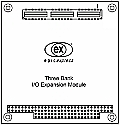 The five board-vendors behind the EPIC form-factor for compact, PC-compatible, embedded SBCs (single-board computers) today unveiled a next-generation spec that adds PCI Express. Dubbed “EPIC Express,” the new spec promises continued support for legacy PC/104 modules, and hints at a next-generation PCI Express-enabled version… of PC/104.
The five board-vendors behind the EPIC form-factor for compact, PC-compatible, embedded SBCs (single-board computers) today unveiled a next-generation spec that adds PCI Express. Dubbed “EPIC Express,” the new spec promises continued support for legacy PC/104 modules, and hints at a next-generation PCI Express-enabled version… of PC/104.
EPIC Express defines the mechanical layout, 28-pin connectors, and pin definitions for a PCI Express module expansion location that accommodates a PC/104-like stack of what are currently dubbed “EPIC Express I/O Expansion cards.” The new modules are the same size as PC/104 and PC/104-Plus modules, but replace the self-stacking 120-pin parallel PCI connector of PC/104-Plus with the newly defined self-stacking serial PCI Express connector.
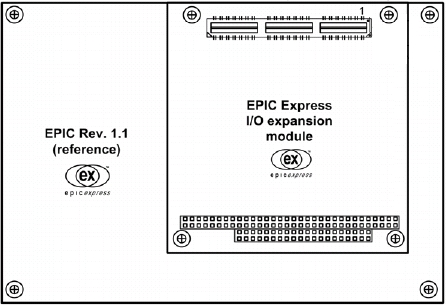
EPIC express replaces PC/104-Plus with its PCI Express equivalent
The new module format thus trades PCI Express for the original PCI of PC/104-Plus, but retains the venerable ISA bus of the original PC/104 standard. Legacy PC/104 (ISA-only) modules can coexist in a stack along with the new PCI Express-enabled modules, provided the PC/104 modules are on top.
Next generation PC/104?
The new EPIC Express expansion module format seems destined to become the next-generation of PC/104, and might end up being called “PC/104-Express.” But that could only happen if the PC/104 Consortium takes EPIC Express under its wing. However, the co-developers of EPIC Express — VersaLogic, Micro/sys, Octagon, WinSystems, and Ampro — have already said they plan to submit the new standard to the Consortium by year end.
The same five companies announced the original EPIC spec in March of 2004, and turned it over to the PC/104 Consortium in January of this year.
Self-stacking PCI Express bus
The PCI Express expansion interface consists of a “high performance” connector scheme that supports up to four self-stacking EPIC Express I/O expansion modules, containing up to six total PCI Express devices.
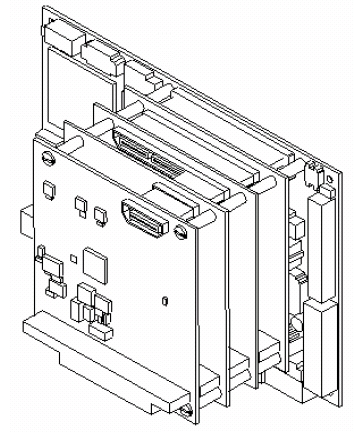
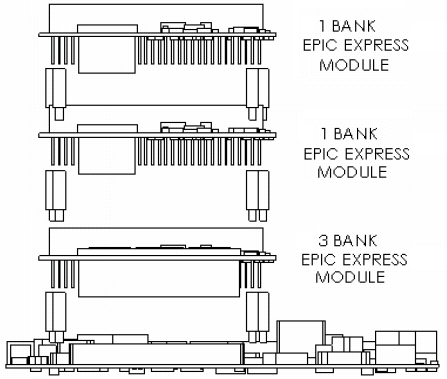
Epic Express stacks PC/104-like modules having up to three PCI Express banks
According to the EPIC Express specification, “a PCI Express link can be scaled on a device-by-device basis to meet different I/O controllers' bandwidth and application objectives.” While PCI Express defines the configuration of serial links as x1, x2, x4, x8, x16, and x32, EPIC Express limits its support to four x1 and two x4 links. This is implemented in two configurations — “Standard” and “Full.”
The spec suggests the use of the Standard module variant as a replacement for PC/104-Plus modules. This version of the spec's PCI Express bus implements just four x1 links (A to D), and allows up to four modules to be stacked using a single 28-pin PCI Express connector.
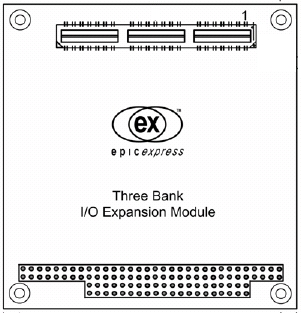
EPIC Express “Full” module option
The Full option, pictured above, supports the four x1 links on the first connector, and adds two x4 links (E and F) plus more clocks, power, and ground on the other two connectors. The three 28-pin connectors of the Full version take up roughly the same area as a PC/104-Plus 120-pin PCI connector.
Standard and Full modules can coexist within a stack, provided the Standard modules are on top.
Analyst comments
Eric Gulliksen, market analyst at Venture Development Corp. (VDC), said: “The industry buzz about PCI Express, coupled with the removal of legacy I/O from the desktop PC platform, has created a dilemma for hundreds of embedded system manufacturers and integrators who use serial ports, parallel ports, floppy drives, EIDE storage devices, and custom I/O. EPIC Express is the only PCI Express-compatible standard to date that supports all of these legacy devices while paving the way to the high-speed serial I/O of the future. EPIC Express should also provide an example for others to consider in the development of similar standards.”
Rick Lehrbaum, executive editor LinuxDevices.com, WindowsForDevices.com, and DeviceForge.com, said: “EPIC includes onboard outside-world or pin-header I/O connectors, which simplifies cabling and saves cost. In that sense, EPIC differs from 'computer-on-module' approaches that don't have onboard I/O connectors and require custom carrier boards for use. EPIC Express follows in the footsteps of EPIC, while cleverly letting PCI Express and legacy ISA-bus I/O modules coexist within a stack. And, most importantly to my readers, it preserves the software and driver compatibility of the legacy devices.”
The five companies say that over a dozen manufacturers have adopted the existing the EPIC form-factor, and that they expect EPIC to “dominate the small form-factor SBC market by the end of the decade.”
EPIC Express is published as an “open standard,” according to the group, and can be obtained at Epic-Express.org.
This article was originally published on LinuxDevices.com and has been donated to the open source community by QuinStreet Inc. Please visit LinuxToday.com for up-to-date news and articles about Linux and open source.